English - IntraHealth International
English - IntraHealth International
English - IntraHealth International
You also want an ePaper? Increase the reach of your titles
YUMPU automatically turns print PDFs into web optimized ePapers that Google loves.
Improving Global Health: It Takes A Workforce<br />
Annual Report 2007
Improving Global Health: It Takes a Workforce<br />
Bringing health care and family planning services to the most vulnerable<br />
families—and responding to the challenges of HIV/AIDS, tuberculosis and<br />
malaria—requires a strong and well-supported health workforce. Yet shortages<br />
and poor distribution of health workers pose serious problems in many<br />
countries. With our partners, <strong>IntraHealth</strong> builds capacity to respond at every<br />
level of the health care continuum—from government decision makers to<br />
teachers and trainers to health workers themselves and the communities<br />
they serve.<br />
Our Core Work<br />
<strong>IntraHealth</strong> empowers health workers to save and improve lives by:<br />
• Supporting health worker performance<br />
• Strengthening policies and systems that support the health workforce<br />
• Extending health care services to meet community needs.
Message from the President<br />
Four years ago, our annual report introduced you to primary health care<br />
providers as “some of the most important people in the world.” Today, we<br />
continue to embrace that theme in the broader context of strengthening<br />
human resources for health. While it has been exciting to see increased<br />
awareness and funding for global health in recent years, real progress<br />
depends on having high-performing, well-supported health workers in the<br />
locations where their services are needed most.<br />
This year’s report highlights <strong>IntraHealth</strong>’s contributions to enable countries to<br />
better plan, develop and support their health workforce to scale up HIV/AIDS<br />
services, revitalize family planning and expand maternal, newborn and child<br />
health programs. These contributions include innovative tools and approaches—<br />
developed through our leadership of USAID’s Capacity Project—for<br />
strengthening human resources planning and management and making<br />
training and learning programs more effi cient and eff ective.<br />
<strong>IntraHealth</strong>’s mission—to mobilize local talent to create sustainable and accessible<br />
health care—refl ects our commitment to supporting all of the cadres and levels<br />
of health workers that contribute to better health outcomes in their communities.<br />
We believe that the leaders, managers and providers in the countries where we<br />
work have the vision for high-quality health care and that it is our role to listen<br />
to their ideas, to rely upon their talent, and to off er resources and knowledge to<br />
help unleash their potential.<br />
I would like to thank USAID, the CDC, the David and Lucile Packard Foundation,<br />
the William and Flora Hewlett Foundation, Pfi zer, and a growing list of donors for<br />
their continued support. We are also grateful to the many partner organizations<br />
for their collaboration and contributions to the global Capacity Project and<br />
country-specifi c projects, especially where those contributions directly support<br />
national plans and programs.<br />
Finally, a big thank you to our own workforce for the passion, creativity and<br />
excellence they bring to their jobs each day.<br />
Pape A. Gaye<br />
President and CEO
Mobilizing Local Talent for Sustainable, Accessible<br />
Generating Generatinng<br />
Data D for Workforce Planning<br />
“Now, with w tthe<br />
information we have, we can tell who is working where. It is helping us a lot in<br />
planning.”—Thembisile planning.”—<br />
”<br />
Khumalo, chief nursing offi cer<br />
In Swaziland, Swazilandd,<br />
a dwindling health workforce provides care to the country’s high number of HIV-<br />
aff ected citizens citizen<br />
while trying to deliver services to meet other pressing needs. To address this<br />
challenge the thhe<br />
Ministry M of Health and Social Welfare urgently needed more information about its<br />
valuable health<br />
workforce. In response, the <strong>IntraHealth</strong>-led Capacity Project introduced its fi ve-<br />
step app approach proa to strengthen human resources information systems. The approach involves<br />
enha enhancing ancin infrastructure, developing software solutions and building leadership and skills<br />
to<br />
o sup support eff ective data use and analysis. As of May 2007, the Ministry had used the<br />
appr aapproach<br />
to analyze 300 vacancies, fi ll gaps, identify bottlenecks to hiring and deploy<br />
work wworkers<br />
more effi ciently.<br />
Scaling Scaliing<br />
Up HIV Services<br />
“We “Wee<br />
ha have been looking for something like this before—and now it is here.”—Dr. Solomon Ole<br />
Logilunore, Lo Log gi gilu lu lun municipal medical offi cer<br />
Ma Making<br />
ngg<br />
routine rouu HIV counseling and testing more available is badly needed in Tanzania, where<br />
7% of f the thhe<br />
population p<br />
is already infected with the disease. In three regions of the country,<br />
In IntraH <strong>IntraHealth</strong> a ealth e and partners are dramatically increasing the numbers of people tested—more<br />
than<br />
an 10 10,000 0,000 during 2007—by enabling more health workers to counsel clients and administer<br />
the<br />
e HIV HI HIV V test tes through provider-initiated testing and counseling. The program integrates HIV<br />
counse counseling se seling<br />
ng and testing in departments throughout clinics and hospitals so that patients<br />
co ccoming ming ng iin<br />
n fo for other reasons have the opportunity to get tested while they are at the facility.<br />
Revitalizing Revitallizin<br />
Family Planning<br />
“We have hhave<br />
to acknowledge the Capacity Project as a real champion, especially in strengthening<br />
the cap capabilities pab of family planning providers. This has improved the quality of services off ered,<br />
which<br />
bro brought about the public’s acceptance.”—Dr. Camille Munyangabe, government family<br />
pl plan planning an a ni ing representative<br />
r<br />
Incr Increasing crea ea easi si sing access acc cc cce to high-quality family planning services is a government priority in<br />
geog geographically ogra ra raphica al ally ly small and densely populated Rwanda. Introducing a decentralized approach<br />
th that<br />
at ena eenables<br />
n bles s d ddis<br />
districts is to organize their own trainings and support for family planning providers,<br />
In Intr <strong>IntraHealth</strong> tr traH aHea e lth h is i is wworking<br />
to develop the capacity of the clinical workforce to provide a full range of<br />
fa fami family mi m ly l plann planning nn nnin<br />
ing services, including long-acting methods. The estimated protection provided to<br />
co couples by contraceptive con c<br />
on ont<br />
methods during a one-year period has tripled in <strong>IntraHealth</strong>-supported<br />
di dist districts stricts si ssince ncce<br />
e 22005.
Health Care A few highlights from our work during 2007…<br />
Taking Knowledge to Practice<br />
“Through the Vistaar Project, <strong>IntraHealth</strong> is helping us to improve our state training program<br />
for skilled birth attendants. The team shared evidence about how important it is to make the<br />
training participatory and skills-based and also about the need to follow up after the training<br />
program, providing support, positive feedback and motivation.”—Nidhi Khare, Ministry of<br />
Health and Family Welfare, State of Jharkhand<br />
Through USAID’s Vistaar Project, <strong>IntraHealth</strong> is assisting the Government of India to identify<br />
the most promising approaches for scaling up services to improve maternal, newborn and<br />
child health and nutritional status. During 2007 the project facilitated six evidence reviews by<br />
recognized technical experts to build consensus among health program leaders, inform program<br />
planners and promote the use of data in decision making. Based on these reviews, the project is<br />
now providing technical assistance to support government health programs in the states of Uttar<br />
Pradesh and Jharkhand in areas such as anemia prevention and treatment, community-based<br />
newborn care and adolescent health.<br />
Developing Innovative Resources<br />
HRIS Strengthening (www.capacityproject.org/hris): A strong human resources information<br />
system (HRIS) enables health care leaders to quickly answer the key policy and management<br />
questions aff ecting health care service delivery. Through its leadership of USAID’s Capacity<br />
Project, <strong>IntraHealth</strong> has developed free, Open Source HRIS software solutions that include a<br />
program of technical assistance and expertise to ensure that the technology is transferred<br />
eff ectively and serves the ability of decision makers to use data to lead and manage. In 2007,<br />
the Project applied its HRIS strengthening approach in Kenya, Lesotho, Namibia, Rwanda,<br />
Southern Sudan, Swaziland, Tanzania and Uganda.<br />
Learning for Performance (www.intrahealth.org/lfp): Too often, education and training<br />
programs for health workers have focused on “know all” rather than “know how” and on<br />
theoretical knowledge instead of practice skills. <strong>IntraHealth</strong>’s Learning for Performance<br />
guide and toolkit is designed to improve health worker performance through more effi cient<br />
training programs that focus on priority on-the-job performance outcomes. <strong>IntraHealth</strong><br />
applied the Learning for Performance approach in Armenia, Bangladesh, Mali and Senegal<br />
in 2007.<br />
Expanding the HRH Knowledge Base (www.hrhresourcecenter.org): A web-based digital library<br />
with over 1,500 resources, the Capacity Project’s HRH Global Resource Center enables health<br />
care leaders, managers and stakeholders to fi nd, share, contribute and use knowledge and<br />
tools on human resources for health. It is rapidly becoming the premier website for HRH<br />
information worldwide. The average number of visits jumped dramatically during 2007, from<br />
3,509 in the fi rst quarter to 27,723 in the fourth quarter.
Statement of Activities and Change in Net Assets for the Year Ended June 30, 2007<br />
Revenue 2007 2006<br />
Contributions — $10,337 $10 337<br />
Grants and contracts $41,188,177 $24,017,931<br />
Interest income $20,931 $1,079<br />
Contributed services and materials $5,014,226 $2,402,011<br />
Other revenue $850 $9,468<br />
Expenses<br />
Program services:<br />
Total Revenue $46,224,184 $26,440,826<br />
Prime Grantee or Contractor $35,983,330 $15,267,680<br />
Subgrantee or Subcontractor $3,094,288 $6,390,931<br />
Total program services $39,077,618 $21,658,611<br />
Supporting services:<br />
Management and General $6,388,305 $4,942,504<br />
Total Expenses $45,465,923 $26,601,115<br />
Change in net assets $758,261 $(160,289)<br />
Net assets at beginning of year $853,870 $1,014,159<br />
Net Assets at End of Year $1,612,131 $853,870<br />
Our Donors and Funders<br />
U.S. Agency for <strong>International</strong> Development<br />
(USAID)<br />
Centers for Disease Control and Prevention<br />
(CDC)<br />
Bill & Melinda Gates Foundation<br />
Global Fund to Fight AIDS, Tuberculosis<br />
and Malaria<br />
David and Lucile Packard Foundation<br />
William and Flora Hewlett Foundation<br />
Pfi zer, Inc.<br />
Individual contributors<br />
Partners<br />
Abt Associates<br />
African Medical and Research Foundation<br />
Aga Khan University<br />
Agency for the Development of Social<br />
Marketing<br />
AIDS Business Coalition of Tanzania<br />
Anglican Medical Service (Namibia)<br />
APEFE (Rwanda)<br />
Autonomous University of Managua,<br />
Health Research and Education Center<br />
Belgium Technical Cooperation<br />
Benjamin Mkapa Foundation (Tanzania)<br />
CARE<br />
Catholic AIDS Action<br />
Catholic Health Service (Namibia)<br />
Catholic Relief Services<br />
CHAMP/CHF (Rwanda)<br />
Christian Health Association of Lesotho<br />
Christian Health Association of Sudan<br />
Christian Social Services Commission<br />
(Tanzania)<br />
Columbia University<br />
Contrasida (El Salvador)<br />
Council for Health Service Accreditation of<br />
Southern Africa<br />
Dangriga AIDS Society (Belize)<br />
Danida<br />
Deloitte and Touche, Kenya<br />
Democratic Resettlement Community<br />
VCT Center (Namibia)<br />
Development Aid from People to People<br />
East, Central and Southern Africa Health<br />
Community<br />
Ecole des Infi rmiers de Gao (Mali)<br />
Elizabeth Glaser Pediatric AIDS Foundation<br />
Emerging Markets Group<br />
EngenderHealth<br />
Ethiopian Society of Obstetrics &<br />
Gynecology<br />
European Union/Developing Human<br />
Resources for Health<br />
Evangelical Lutheran Church Program<br />
Family Health <strong>International</strong><br />
Female Health Foundation (Senegal)<br />
Foundation for Professional Development<br />
Government of India<br />
GTZ<br />
Hand in Hand Ministries (Belize)<br />
Health Resources & Services Administration<br />
Helen Keller <strong>International</strong><br />
HIV Clinicians Society (Namibia)<br />
Human Resources and Institutional<br />
Capacity Development Agency<br />
(Rwanda)<br />
Humanitas (Costa Rica)<br />
IMA World Health<br />
<strong>International</strong> Federation of Gynecology<br />
and Obstetrics<br />
<strong>International</strong> Medical Corps<br />
<strong>International</strong> Save the Children Alliance<br />
Jhpiego<br />
John Snow, Inc.<br />
Johns Hopkins University Center for<br />
Communications Programs<br />
Kenya Institute of Administration<br />
Kenya Medical Training College<br />
Kigali Health Institute (Rwanda)<br />
Lifeline/Childline (Namibia)<br />
Liverpool Associates in Tropical Health<br />
Lutheran Medical Service (Namibia)<br />
Maer Associates<br />
Management Sciences for Health<br />
Merlin<br />
MildMay <strong>International</strong><br />
Ministries of health, education, fi nance<br />
and social welfare in the countries<br />
where we work<br />
Namibia Red Cross Society<br />
National AIDS, Malaria and TB Research<br />
and Treatment Center (Rwanda)<br />
National HIV/AIDS and STD Control<br />
Program (Kenya)
National Institute for Medical Research<br />
(Tanzania)<br />
Pan American Health Organization<br />
Pathfi nder <strong>International</strong><br />
Pharmaceutical Society of Namibia<br />
Population Council<br />
Population Services <strong>International</strong><br />
Pro-Femmes (Rwanda)<br />
Program for Appropriate Technology<br />
in Health<br />
Proyecto Vida (Guatemala)<br />
PS Consulting (Uganda)<br />
REDSAL (El Salvador)<br />
Regional Centre for Quality of Health Care/<br />
Makerere University, Uganda<br />
Leadership<br />
<strong>IntraHealth</strong> Board of Directors<br />
Jeff rey L. Houpt, MD, Chair<br />
Dean Emeritus, School of Medicine,<br />
University of North Carolina at<br />
Chapel Hill<br />
Peggy Bentley, PhD<br />
Professor of Nutrition and Associate<br />
Dean for Global Health, University of<br />
North Carolina at Chapel Hill<br />
George Brown, MD, MPH<br />
<strong>International</strong> health specialist in<br />
reproductive health and HIV/AIDS<br />
policy and programs<br />
Barry Eveland<br />
Retired IBM Senior State Executive for<br />
North Carolina<br />
Pape Amadou Gaye, MBA<br />
President and CEO, <strong>IntraHealth</strong><br />
<strong>International</strong><br />
Duff Gillespie, PhD<br />
Senior Scholar and Professor, Bill and<br />
Melinda Gates Institute for Population<br />
and Reproductive Health at the Johns<br />
Hopkins Bloomberg School of Public<br />
Health<br />
Anu Kumar, PhD, MPH<br />
Executive Vice President, Ipas<br />
Maurice Middleberg, PhD<br />
Vice President for Policy Research and<br />
Advocacy, Global Health Council<br />
Gordon Perkin, MD<br />
Co-Founder, Program for Appropriate<br />
Technology in Health (PATH)<br />
Khama Rogo, MD, PhD<br />
Lead Health Sector Specialist, the<br />
World Bank<br />
Beth Traynham, MS, CPA<br />
Partner, Hughes Pittman & Gupton, L.L.P<br />
RTI <strong>International</strong><br />
Rwandan Health Workers Union<br />
Rwandan Association of Local Government<br />
Authorities<br />
Samaritan’s Purse<br />
Save the Children<br />
Siggil Jiggen (Senegal)<br />
Society for African Gynecologists and<br />
Obstetricians<br />
Society of Obstetricians-Gynecologists<br />
of Canada<br />
St. Bakhita Health Center (Southern Sudan)<br />
Sudanese People’s Liberation Army<br />
Systems Research and Applications<br />
Corporation<br />
<strong>IntraHealth</strong> Executive Team<br />
Pape Amadou Gaye, MBA<br />
President and CEO<br />
Maureen Corbett, MIA<br />
Vice President of Programs<br />
D. Randolph Heaton<br />
Vice President of Finance and Chief<br />
Financial Offi cer<br />
Rebecca Kohler, MPH<br />
Vice President of External Aff airs<br />
Mary C. Scott<br />
Vice President of Operations<br />
Anne Wilson, MSN<br />
Director, Capacity Project<br />
<strong>IntraHealth</strong> Country and Project<br />
Directors/Country Coordinators<br />
Armenia<br />
Inna Sacci, MA<br />
Chief of Party, Project NOVA<br />
Ethiopia<br />
Yetnayet Demessie Asfaw, MD, MPH<br />
Country Director<br />
Guatemala<br />
Jose Zelaya, MD, MPH<br />
Country Coordinator, Capacity Project<br />
India<br />
Laurie Noto Parker, MPH<br />
Chief of Party, Vistaar Project<br />
Kenya<br />
Kimani Mungai, MA<br />
Program Director, Capacity Project<br />
Mali<br />
Cheick Touré, MD<br />
Country Director<br />
Namibia<br />
Emad Aziz, MSc<br />
Chief of Party, Capacity Project<br />
Training Resources Group, Inc.<br />
Tulane University<br />
Uganda National Association for Nurses<br />
and Midwives<br />
Uganda Nursing Council<br />
UNICEF<br />
United Nations Population Fund<br />
United Nations World Food Program<br />
University of Belize, Faculty of Nursing<br />
and Allied Health<br />
University of Costa Rica<br />
University of El Salvador, Master’s<br />
Degree Program on Sexual and<br />
Reproductive Health<br />
Rwanda<br />
Karen Blyth, MS<br />
Chief of Party, USAID HIV/AIDS Clinical<br />
Services Program<br />
Ousmane Faye, MD<br />
Chief of Party, Capacity Project<br />
Laura Hoemeke, MPH<br />
Director, Twubakane Decentralization<br />
and Health Program<br />
Senegal<br />
Rodio Diallo<br />
Chief of Party, USAID Maternal, Neonatal<br />
and Child Health, Family Planning,<br />
Malaria Project<br />
South Africa<br />
Stembile Mugore, RN<br />
Chief of Party, Southern Africa Human<br />
Capacity Development Coalition<br />
Southern Sudan<br />
Agnes Comfort<br />
Capacity Project Coordinator<br />
Carol Karutu, MPH<br />
Program Manager, CDC Southern Sudan<br />
Project<br />
Tanzania<br />
Moshi Ntabaye, PhD<br />
Project Director, CDC Provider-Initiated<br />
Testing and Counseling Project<br />
William Nyagwa, MPA<br />
Chief of Party, Capacity Project<br />
Uganda<br />
Vincent Oketcho, MD<br />
Chief of Party, Capacity Project<br />
Zambia<br />
Namoonga Winnie Hamoonga<br />
Team Leader, CDC Improving Access<br />
and Uptake of Routine Confi dential<br />
Counseling and Testing Program<br />
University of North Carolina Institute for<br />
Global Health and Infectious Diseases<br />
University of North Carolina School of<br />
Medicine, Family Medicine Department<br />
VNG <strong>International</strong><br />
Walvis Bay Multi-Purpose Centre (Namibia)<br />
West Coast Network of PLHIV (Nicaragua)<br />
William J. Clinton Foundation<br />
World Bank<br />
World Health Organization<br />
Youssou N’Dour Foundation<br />
In 2007 we also worked in...<br />
Bangladesh<br />
Belize<br />
Costa Rica<br />
Democratic Republic of Congo<br />
El Salvador<br />
Indonesia<br />
Jordan<br />
Lesotho<br />
Liberia<br />
Malawi<br />
Nepal<br />
Nicaragua<br />
Pakistan<br />
Panama<br />
Swaziland<br />
Togo<br />
Ukraine<br />
Vietnam
<strong>IntraHealth</strong> <strong>International</strong>, Inc.<br />
Suite 200<br />
6340 Quadrangle Drive<br />
Chapel Hill, North Carolina 27517<br />
Tel: 919-313-9100<br />
Fax: 919-313-9108<br />
www.intrahealth.org<br />
intrahealth@intrahealth.org<br />
Photography by Christopher Wilson and Charles Harris, by Greg Plachta, and by <strong>IntraHealth</strong> staff members.
We assisted<br />
local leaders<br />
to improve<br />
more than<br />
2,100<br />
health care<br />
facilities.<br />
We enabled providers<br />
to test more than<br />
188,000<br />
clients for HIV,<br />
including<br />
91,000<br />
pregnant women.<br />
Improving Global Health: It Takes A Workforce<br />
Growth and<br />
Impact During<br />
2007<br />
We supported the<br />
training of more than<br />
17,000<br />
health workers.<br />
We supported<br />
provision of<br />
antiretroviral<br />
therapy to over<br />
13,700<br />
HIV-infected<br />
individuals.<br />
We helped ensure<br />
that more than<br />
148,000<br />
women received<br />
assistance during<br />
delivery by a skilled<br />
birth attendant.


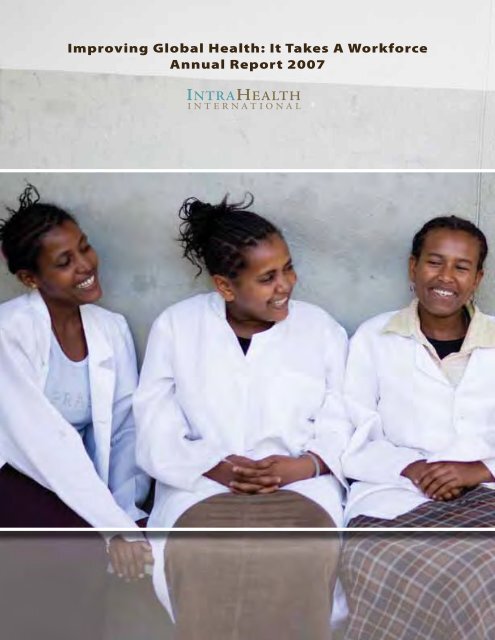
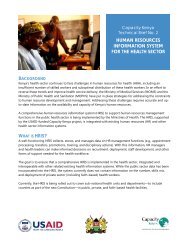
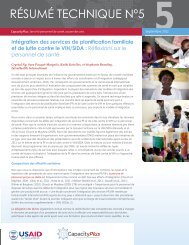
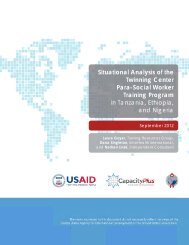
![view Unit 14: Emergency Contraceptive Pills [PDF 319KB]](https://img.yumpu.com/50082157/1/184x260/view-unit-14-emergency-contraceptive-pills-pdf-319kb.jpg?quality=85)
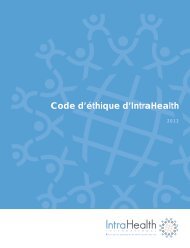
![view Unit 8: Intrauterine Contraceptive Devices [PDF 992KB]](https://img.yumpu.com/47853006/1/184x260/view-unit-8-intrauterine-contraceptive-devices-pdf-992kb.jpg?quality=85)
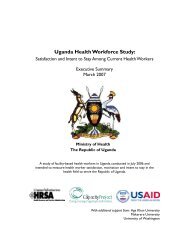
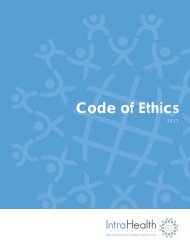
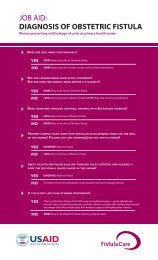

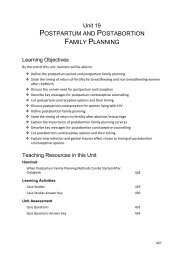
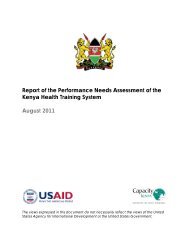
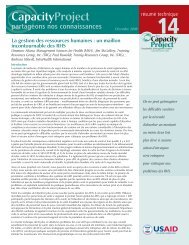
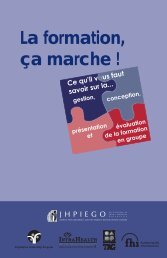
![view Unit 15: Lactational Amenorrhea Method [PDF 259KB]](https://img.yumpu.com/30000479/1/184x260/view-unit-15-lactational-amenorrhea-method-pdf-259kb.jpg?quality=85)